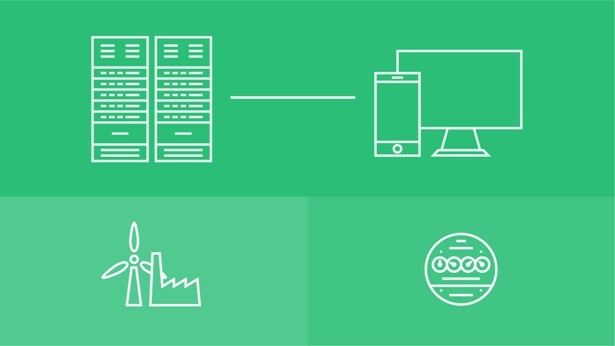If you’re reading this article, it’s likely that you use the internet on a daily basis.
While you’re probably aware of the energy used to power or charge the device you’re using, you probably aren’t conscious of the fact that the servers used to transmit the very text you’re reading are most likely powered by non-renewable energy. In fact, approximately 87% of energy produced in the United States is provided by non-renewable energy, mainly coal, natural gas and nuclear.
So, we’re here to help you understand the invisible yet significant environmental footprint of using the internet—and how to take steps to mitigate its impact.
First things first, let’s put that impact into perspective:
1. According to the National Resource Defense Council, U.S. data servers consumed 91 billion kilowatt-hours (kwh) of electricity in 2013. This is equivalent to the annual output of 34 large coal plants. And it’s only going to increase—data center electricity consumption is projected to rise to 140 billion kwh by 2020 (roughly 16 additional power plants).
2. This will result in nearly 100 million metric tons of carbon pollution per year. To put this number into perspective, it’s the equivalent of the average CO2 output of 20 million passenger cars.
3. And these numbers don’t even include the energy used to power all of our internet-capable devices, whose energy once again is primarily sourced from non-renewables.
The amount of energy used—and perhaps most importantly, the type of energy used—is in the hands of everyone from consumers and business owners to web designers and developers. With a little bit of motivation and persistence, anyone that plays a part in creating or interacting with content on the web can contribute towards a more sustainable internet.
When looking to lower the carbon footprint of the web, we should consider both the energy consumption and the energy source. When it comes to energy consumption, the basic idea is that the less time someone is interacting with a web site or application, the less energy is used on both their device and the server that is sending and processing data.
Often, as eco-minded consumers, we’ll find ourselves compulsively turning off light switches in unoccupied rooms yet we won’t hesitate to browse social media for three hours a day.
The amount of energy usage needed to run and charge our devices seems minuscule compared to running an air conditioner in our home, but reminding ourselves that somewhere out there an air conditioned server is powering our interaction may give us the motivation to be a little bit more mindful of our screen time.
Content creators and developers also play a direct role in energy consumption. Facilitating an efficient experience means that the user needs less time to accomplish their goals. This means that intuitive navigation, quick loading times and well-planned interfaces can all contribute to a more efficient experience for the user. As a welcomed side effect, this also tends to result in a more satisfied user, so in effect good design on the web is also green design.
While lowering energy consumption is always a good thing—and small changes do add up when executed on a large scale—the greatest difference can be made with the energy source. On the server side of things, the bulk of the energy usage goes toward server uptime and cooling.
In other words, ensuring that the server is powered with a renewable energy source is the ideal solution.
There are many serviceable hosts powered by renewable energy, but the overall demand is still far too low.
In order to foster the competitive landscape that will produce renewable-energy-powered hosts that are also leading the industry in performance, service, and cost, we need to increase demand.
For many digital products, only the top tier hosts with the most extensive positive reputations will do. If you find yourself in this scenario, contact those host providers and ask about their plans for green hosting and explain that for you this would give them an edge against their close competitors.
In the interim, if you must use traditionally powered servers, you can still offset your carbon footprint with third-party Carbon Offsets (VERs—Verified Emissions Reduction) or Renewable Energy Credits (RECs). The average dedicated server would fall between 1–2 mT of carbon emissions.
Given that the typical website utilizes a small fraction of a server’s resources, the cost of offsetting the average website’s server emissions for one year should fall well below the minimum purchase levels (usually around $5–$15) for VER and REC vendors.
For consumers, the energy that powers your devices ties into greater struggles that we won’t dive deeply into for this article (e.g. creating/demanding better energy sources for you and your region), but consumers also have the power to influence content creators and developers.
If you use a website or application often, get in touch with the content creators and ask if they are hosted on green servers or if they are offsetting their servers’ carbon footprint in some way. Support and promote those that do, just as you would any other company that is going out of their way to do the right thing.
With a little effort, we can all take steps towards a greener internet.
~
Sources:
United States Energy & Information Administration: Energy Explained.
Natural Resources Defense Council.
United States Environmental Protection Agency: Greenhouse Gas Equivalencies Calculator.
Terrapass: Carbon Footprint Calculator.
~
Author(s): Jonathan Black & Richard Roche
Editor: Alli Sarazen
Photos: Author’s Own
~
Bonus: imgur: “Before and after powerwashing. New York used to be a much dirtier city back when the Northeast ran on coal plants.”







Read 3 comments and reply